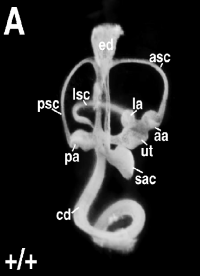2012 Group Project 6: Difference between revisions
| Line 40: | Line 40: | ||
Various evidence indicates the existence of this pre-placodal region: | Various evidence indicates the existence of this pre-placodal region: | ||
* Morphology indicates a thickened band of ectoderm around the anterior neural plate in some species, including mice and humans. As time progresses, this thickening will only be present at the locations where the different craniofacial placodes differentiate - including the otic placode.<ref><pubmed>15531360</pubmed></ref> | |||
* Experiments have also shown that the placodes will only develop in the correct location, if rotation of the ectoderm along the anteroposterior axis takes place at the open neural plate stage. If rotation takes place at a later time, the placodes will form at incorrect places.<ref><pubmed>14100031</pubmed></ref> | |||
* Gene expression has also indicated that particular genes are present in the pre-placodal domain. These genes belong to the Dlx, Six, Eya, Iro, BMP, Foxi and Msx families. Glavic et al. (2004) has shown that 'loss and gain of function of some of these genes | |||
resulted in the widening or reduction of the pre-placodal field'. Linked to this was also the domain of expression of some placode-specific genes; which either enlarged or diminished.<ref><pubmed>15242793</pubmed></ref> | |||
Gene expression has also indicated that particular genes are present in the pre-placodal domain. These genes belong to the Dlx, Six, Eya, Iro, BMP, Foxi and Msx families. Glavic et al. (2004) has shown that 'loss and gain of function of some of these genes | |||
resulted in the widening or reduction of the pre-placodal field'. Linked to this was also the domain of expression of some placode-specific genes; which either enlarged or diminished. | |||
Revision as of 14:25, 26 August 2012
Hearing Development
Introduction
History
Adult Anatomy and Histology
Outer ear: Pinna, Auricle and Tympanic membrane
Middle ear: Ossicles (Malleus, Incus and Stapes) and Muscles (Tensor Tympani and Stapedius)
Inner ear: Bony and Membranous Labyrinth - Cochlea containing the Organ of corti, Vestibule containing Utricle and Saccule and Semi-circular canals containing semi-circular ducts
Development
Outer Ear
Middle Ear
Inner Ear
The entire inner ear, as well as the neurons which innervate the sensory organ, are derived from the otic placode. The otic placode is a thickened portion of ectoderm located on the each side of the developing head of the embryo, next to the hindbrain. It is generally visible after gastrulation, once the first 5 to 10 pairs of somites have formed. Invagination occurs next, which creates the otocyst - a vesicle which will develop into the different components of the inner ear: the cochlea, the semicircular canals with cristae, the utricle, the saccule and the vestibulo-acoustic ganglion. [1]
Induction of the otic placode
Experiments with molecular markers have revealed that several steps are needed for induction of the otic placode. We will consider the three major steps:
1 Pre-placodal domain
The pre-placodal domain is a narrow strip of the ectoderm adjacent to the anterior neural plate after gastrulation. Different placodes arise from the pre-placodal domain. All the craniofacial sensory organs, including the ear, develop from these different placodes located at the periphery of the neural plate.
Various evidence indicates the existence of this pre-placodal region:
- Morphology indicates a thickened band of ectoderm around the anterior neural plate in some species, including mice and humans. As time progresses, this thickening will only be present at the locations where the different craniofacial placodes differentiate - including the otic placode.[2]
- Experiments have also shown that the placodes will only develop in the correct location, if rotation of the ectoderm along the anteroposterior axis takes place at the open neural plate stage. If rotation takes place at a later time, the placodes will form at incorrect places.[3]
- Gene expression has also indicated that particular genes are present in the pre-placodal domain. These genes belong to the Dlx, Six, Eya, Iro, BMP, Foxi and Msx families. Glavic et al. (2004) has shown that 'loss and gain of function of some of these genes
resulted in the widening or reduction of the pre-placodal field'. Linked to this was also the domain of expression of some placode-specific genes; which either enlarged or diminished.[4]
2 Pre-otic field
Once the general placodal state has been established, the identity of each placode is induced by local signals. The optic placode is induced by various signals, including Pax8, Pax2, Fibroblast Growth Factors (FGFs), and many transciption factors.
3 Otic placode/epidermis fate decision
Abnormal Hearing
Genetic
Syndromic hearing loss
Non syndromic hearing loss
1 Mutation of GJB2 gene
Environmental
Infections
1 Rubella
2 Herpes
3 Syphilis
4 Toxoplasmosis
Drugs
1 Alcohol consumption during pregnancy
2 Chemotherapy
3 Accutane
Structural malformation of the ear
1 Stenosis
2 Enlarged vestibular aqueduct
3 Auricular Appendages
4 Absence of the Auricle
5 Microtia
6 Preauricular Sinuses and fistulas
7 Atresia of External Acoustic Meatus
8Absence of external acoustic meatus
9 Congenital cholesteatoma
Technologies to detect
Technologies to overcome the problems
Current Research
Glossary
References
External Links
External Links Notice - The dynamic nature of the internet may mean that some of these listed links may no longer function. If the link no longer works search the web with the link text or name. Links to any external commercial sites are provided for information purposes only and should never be considered an endorsement. UNSW Embryology is provided as an educational resource with no clinical information or commercial affiliation.
--Mark Hill 12:22, 15 August 2012 (EST) Please leave the content listed below the line at the bottom of your project page.
2012 Projects: Vision | Somatosensory | Taste | Olfaction | Abnormal Vision | Hearing
